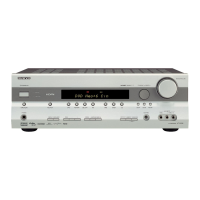53
Advanced Setup
—Continued
Crossover Frequency
This setting only applies to the speakers that you speci-
fied as
Small
in the “Speaker Configuration” on page 52.
To get the best bass performance from your speaker sys-
tem, you need to set the crossover frequency according
to the size and frequency response of your speakers
Notes:
•For a more accurate setting, look up the frequency
response in the manuals supplied with your speakers
and set accordingly.
• Choose a higher crossover frequency if you want more
sound from your subwoofer.
• These settings cannot be changed while headphones
are connected or the multichannel DVD input is being
used.
Double Bass
With the Double Bass function, you can boost bass out-
put by feeding bass sounds from the front left and right
channels to the subwoofer. This function can be set only
if the Subwoofer setting (step 3) is set to Yes, and the
Front setting (step 4) is set to Large in the Speaker Con-
figuration on page 52.
Note:
• These settings cannot be changed while headphones
are connected or the multichannel DVD input is being
used.
7
Use the Down [ ] button to
select “Crossover,” and then use
the Left and Right [ ]/[ ] but-
tons to select a crossover fre-
quency.
Use the diameter of the smallest
speaker in your system when choosing
the crossover frequency.
*Choose the setting suitable for the speaker.
Continue with step 8 of the “Double
Bass” setting on the right column.
This setting is set automatically by the Automatic
Speaker Setup function (see page 33).
Speaker cone
diameter
Crossover
frequency
Over 8 in.
(20 cm)
40/50/60Hz*
6-1/2 to 8 in.
(16–20 cm)
80Hz
5-1/4 to 6-1/2 in.
(13–16 cm)
100Hz (default)
3-1/2 to 5-1/4 in.
(9–13 cm)
120Hz
Under 3-1/2 in.
(9 cm)
150/200Hz*
8
Use the Down [ ] button to
select “Double Bass,” and then
use the Left and Right [ ]/[ ]
buttons to select:
On:
Double Bass function on.
Bass from the front left and
right channels is also fed to
the subwoofer (default).
Off:
Double Bass function off.
9
Press the [SETUP] button.
Setup closes.
This setting is not set automatically by the Automatic
Speaker Setup function (see page 33).
SETUP
HT-R508En.book Page 53 Wednesday, March 14, 2007 10:12 AM

